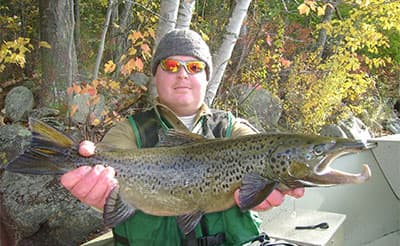Home → Fishing & Boating → Fishing → Maine Fishing Guide → How to Bring Home a Quality Catch
How to Bring Home a Quality Catch

One of the greatest benefits of fishing is being able to cook and consume fish that rivals and surpasses the quality and freshness of what you'd find in the finest dining establishments. However, catching and keeping a prize fish is no guarantee of such experience, as quality is highly dependent upon post-catch care. The following steps can help ensure the quality of your catch.
- Make sure it's legal and safe. Before making the decision to keep your catch, reference the Open Water and Ice Fishing Laws and safe eating guidelines in Maine for the area you're fishing to determine what size fish are legal to harvest and applicable fish consumption advisories. There is a statewide consumption advisory for mercury and some waters also contain other pollutants such as PCBs and subject to more restrictive consumption advisories.
- Keep it cool. Degradation is a function of time and tempera- ture, so make sure you are able to rapidly cool or keep your catch cold. For most of the year, a cooler with ice works best. When water temperature is about 40°F or less, a stringer to hold your fish in the water can also work well. Even though the water may feel cold to the touch, it may not be cold enough to preserve your catch for lengthier periods of time. If using a stringer, be sure your catch is not still alive.
- Kill quickly and humanely. Quick dispatch is as much about quality as it is about being humane, and it's also the law! Allowing your catch to have a prolonged, stressful death will result in lactic acid production and a lower resting pH of the fish flesh. The low pH results in gaping and softer, rather than firm, flesh. Fish can be dispatched quickly with a blow to the head or with bleeding by cutting the gill arches with a knife or scissors. Although bleeding can improve the taste of some species, the main benefit of the practice is that it kills fish quickly.
- Clean your fish. Enzymatic activity of organs and bacteria of the GI tract can spoil your catch if these parts are not quickly removed. If you're planning to cook your fish whole (good for smaller, tasty fish such as brook trout), cleaning it is a must.
For larger fish, you may choose to fillet for cooking. Filleting is a fast method of cleaning fish that maximizes meat and minimizes bones. To do it properly, you'll need a fillet knife with a long, slender, flexible blade.
Helpful tutorials for cleaning and fileting fish can both be found online; but sometimes the best way to learn how to clean a fish is to just try it. Don't let the technicalities discourage you—just follow the steps below:
- To begin, rest the fish on the table or cutting board. Insert the knife tip into the fish's belly near the anal opening and move the blade up along the belly, cutting to the head. Keep the knife blade shallow so you don't puncture the intestines.
- Spread the body open and remove all of the entrails and rinse and clean promptly if intestinal contents are accidentally cut and spilled within the body cavity.
- Dark flesh near the back bone is the kidney. Remove it by scraping it out with a spoon or your thumbnail.
- Rinse the cavity out with a good stream of water and wash the skin. Some fish have a dark tissue lining the abdominal cavity that can be scraped off to prevent a strong, oily flavor.
- Remove the head if you like, though trout are often cooked with the head on. Note: It is unlawful to alter the length of landlocked salmon, trout, togue, lake whitefish, and bass unless the fish is being prepared for immediate cooking, so do not remove the head until then.
- Clean up, cook, and enjoy: Clean your fish-cleaning table, collect the guts, heads, and scales, and discard them properly. Your clean fish is now ready to be cooked.
Please review Maine's Freshwater Fish Consumption Advisory at mefishwildlife.com/fishconsumptionadvisory